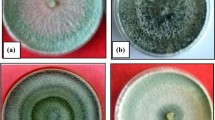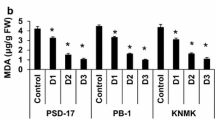Abstract
Water scarcity is one of the primary consequences of climate change, which negatively affects crop growth and productivity. Current research focuses on the effect of an antagonistic fungus, Trichoderma harzianum, on drought stress management in rice. Of 30 Trichoderma isolates examined, only seven isolates, namely IRRI 1, TH 28, TH 21, TH 30, TH 3, TH 26, and TH 7 were selected as drought tolerant due to their ability to colonize well on de-oiled cake of Neem at low moisture content of 10 to 20 percent. These isolates were used as seed biopriming to test their ability to improve drought tolerance in tillering stage of rice. T. harzianum strains IRRI-1, TH-28, TH-30, and TH-21 showed the greatest reduction in leaf rolling after six, nine, and twelve days of drought exposure. These most potent strains, IRRI-1, TH-28, TH-30, and TH-21, were also able to improve drought tolerance in rice plants by minimizing proline content and increasing the leaf total chlorophyll content, leaf area index, relative water content, and Membrane Stability Index. Thus, it was found that Trichoderma harzianum strains IRRI-1, TH-28, TH-30 and TH-21 are very effective in providing drought tolerance in rice plants by interfering with the morphological, physiological and biochemical activities of rice plants. Colonization of rice seeds by drought-tolerant Trichoderma harzianum strains increased growth and delayed drought response in rice, which could be very critical and helpful in rice crop production, especially under drought conditions.





Similar content being viewed by others
References
Adams P, De-Leij FAAM, Lynch JM (2007) Trichoderma harzianum Rifai 1295–22 mediates growth promotion of crack willow (Salix fragilis) saplings in both clean and metal- contaminated soil. Microb Ecol 54:306–313
Ahanger AM, Agarwal RM, Tomar SN, Shrivastava M (2015) Potassium induces positive changes in nitrogen metabolism and antioxidant system of oat (Avena sativa L cultivar Kent). Journal of Plant Interactions 10:211–223
Ahanger MA, Tyagi SR, Wani MR, Ahmad P (2014) Drought tolerance: Roles of organic osmolytes, growth regulators and mineral nutrients. In: Ahmad P, Wani MR (eds) Physiological Mechanisms and Adaptation Strategies in Plants under Changing Environment. Springer, pp 25–56
Ahmad P, Hashem A, Abd-Allah EF, Alqarawi AA, John R, Egamberdieva D, Gucel S (2015) Role of Trichoderma harzianum in mitigating NaCl stress in Indian mustard (Brassica juncea L) through antioxidative defense system. Front Plant Sci 14(6):868
Ali S, Charles TC, Glick BR (2014) Amelioration of high salinity stress damage by plant growth-promoting bacterial endophytes that contain ACC deaminase. Plant Physiol Biochem 80:160–167
Alwahibi M, Hashem A, Allah A, Fathi E, Alqarawi A, Wafi D, Soliman K, Wirth S, Egamberdieva D (2017) Increased resistance of drought by Trichoderma harzianum fungal treatment correlates with increased secondary metabolites and proline content. J Integr Agric 16:1751–1757
Barrs HD, Weatherly PE (1962) A re-examination of the relative turgidity for estimating water deficits in leaves. Aust J Biol Sci 15:413–428
Bates LS, Waldran RP, Teare ID (1973) Rapid determination of free proline for water studies. Plant Soil 39:205–208
Bailey BA (2008) The drought response of Theobroma cacao (cacao) and the regulation of genes involved in polyamine biosynthesis by drought and other stresses. Plant Physiol Bioch 46:174–188
Cardona R, Rodriguez H (2006) Effect of Trichoderma harzianum fungus on the incidence of the charcoal rot disease on sesame. Rev Fac Agron 23:42–47
Chelah MKB, Nordin MNB, Musliania MI, Khanif YM, Jahan MS (2011) Composting increases BRIS soil health and sustains rice production on BRIS soil. Sci Asia 37:291–295
Chowdappa P, Kumar S, Lakshmi M, Upreti KK (2013) Growth stimulation and induction of systemic resistance in tomato against early and late blight by Bacillus subtilis OTPB1 or Trichoderma harzianum OTPB3. Biol Control 65:109–117
Dionisio-Sese ML, Tobita S (1998) Antioxidant responses of rice seedlings to salinity stress. Plant Sci 135:1–9
Fang Y, Xiong L (2015) General mechanisms of drought response and their application in drought resistance improvement in plants. Cell Mol Life Sci 72:673–689
Farooq M, Wahid A, Kobayashi N et al (2009) Plant drought stress: effects, mechanisms and management. Agron Sustain Dev 29:185–212
Gachomo EW, Kotchoni SO (2008) The use of Trichoderma harzianum and T. viride as potential biocontrol agents against peanut microflora and their effectiveness in reducing aflatoxin contamination of infected kernels. Biotechnology 7:439–447
Gifford RM, Thorne JH, Hitz WD, Giaquinta RT (1984) Crop productivity and photoassimilate partitioning. Science 24:801–808
Gusain YS, Singh US, Sharma AK (2014) Enhance activity of stress related enzymes in rice (Oryza sativa L.) induced by plant growth promoting fungi under drought stress. Afr J Agric Res 9:1430–1434
Harman GE, Howell CR, Viterbo A, Chet I, Lorito M (2004) Trichoderma species—opportunistic, avirulent plant symbionts. Nat Rev Microbiol 2:43–56
Harman GE (2006) Overview of mechanism and uses of Trichoderma spp. Phytopathology 96:190–194
Hashem A, Abd-AllahAlqarawiEgamberdieva EFAAD (2015) Bioremediation of adverse impact of cadmium toxicity on Cassia italica Mill by arbuscular mycorrhizal fungi. Saudi J Biol Sci 23:39–47
Hashem A, Abd-AllahAlqarawiAl-HuqailWirthEgamberdieva EFAAAASD (2016) The Interaction between arbuscular mycorrhizal fungi and endophytic bacteria enhances plant growth of Acacia gerrardii under salt stress. Front Microbiol 7:1089
Hermosa R, Viterbo A, Chet I, Monte E (2012) Plant-beneficial effects of Trichoderma and of its genes. Microbiology 158:17–25
IRRI (International rice research institute). (1996). standard evaluation system for rice. 4th edd. Int. Network for Genetic Evaluation of Rice, Genetic Resource Center, Los Baños, The Philippines
Lesk C, Rowhani P, Ramankutty N (2016) Influence of extreme weather disasters on global crop production. Nature 529:84–87
Morris ML, Blaid A, Byerlee (1991) Wheat and barley production in rain fed marginal environments of the developing world. In: Part I of 1990–91 CIMMYT world wheat facts and trends: wheat and barley production in rainfed marginal in environment of the developing world, CIMMYT, México, D.F, p 51
Nayyar H, Gupta D (2006) Differential sensitivity of C3 and C4 plants to water deficit stress: association with oxidative stress and antioxidants. Environ Exp Bot 58:106–113
Passioura JB (2007) The drought environment: physical, biological and agricultural perspectives. J Exp Bot 58:113–117
Prashant S, Ramji S, Madhu GS, Vinit PS (2022) Standardization of optimal moisture level on population density, longevity and multiplication of drought tolerant T harzianum isolates on de-oiled cake of Neem. The Pharma Innovation. 11(5):2509–2514
Petcu E, Terbea M (1995) Proline content and the conductivity test as screening methods for frost tolerance of winter wheat. BULG J PLANT PHYSIOL 21:3–11
Rathore JS (2004) Drought and household coping strategies: a case of Rajasthan. Indian J Agric Econ 59:689–708
Rodriguez RJ, Henson J, Van Volkenburgh E, Hoy M, Wright L et al (2008) Stress Tolerance in Plants via Habitat-Adapted Symbiosis. Int Soc Microb Ecol 2:404–416
Saadalla MM, Quick JS, Shanahan JF (1990) Heat Tolerance in winter wheat: II. Membrane thermostability and fild performance. Crop Sci 30:1248–1251
Shivakumar S, Kerbart E (2004) Drought, sustenance and livelihoods: “Akal” survey in Rajasthan. Econ Polit 39:285–294
Shukla N, Awasthi RP, Rawat L, Kumar J (2012) Biochemical and physiological responses of rice (Oryza sativa L.) as influenced by Trichoderma harzianum under drought stress. Plant Physiol Biochem 54:78–88
Shukla N, Awasthi RP, Rawat L, Kumar J (2015) Seed biopriming with drought tolerant isolates of Trichoderma harzianum promote growth and drought tolerance in Triticum aestivum. Annals of Applied Biology 166:171–182
Stickler FC, Pauli AW, Pavli A (1961) Leaf area determination in grain sorghum. Agron J 53:188–189
Tao H, Brueck H, Dittert K, Kreye C, Lin S, Sattelmacher B (2006) Growth and yield formation of rice (Oryza sativa L.) in the water-saving ground cover rice production system (GCRPS). Field Crops Res 95:1–12
Yedidia I, Srivastva AK, Kapulni Y, Chet I (2001) Effect of trichoderma harzianum on microelement concentrations and increase growth of cucumber plants. Plant soil 235:235–242
Zhifang G, Loescher WH (2003) Expression of a celery mannose 6-phosphate reductase in Arabidopsis thaliana enhances salt tolerance and induces biosynthesis of both mannitol and a glucosyl-mannitol dimmer. Plant Cell Environ 26:275–283
Acknowledgements
The authors are highly grateful to the Vice-Chancellor, Sardar Vallabhbhai Patel University of Agriculture and Technology, Meerut, for providing all facilities for carrying out the research work.
Author information
Authors and Affiliations
Contributions
PS: Conducted pot experiment, collected soil samples and isolated Trichoderma samples. RS: Designed experiment, edited manuscript and data analysis. MGS: Trichoderma isolation, Written manuscript. VPS: collected soil samples and data recorded.
Corresponding author
Ethics declarations
Conflict of interest
All authors declare that they have no conflict of interest.
Additional information
Publisher's Note
Springer Nature remains neutral with regard to jurisdictional claims in published maps and institutional affiliations.
Rights and permissions
Springer Nature or its licensor (e.g. a society or other partner) holds exclusive rights to this article under a publishing agreement with the author(s) or other rightsholder(s); author self-archiving of the accepted manuscript version of this article is solely governed by the terms of such publishing agreement and applicable law.
About this article
Cite this article
Singh, P., Singh, R., Madhu, G.S. et al. Seed Biopriming with Trichoderma Harzianum for Growth Promotion and Drought Tolerance in Rice (Oryza sativus). Agric Res 12, 154–162 (2023). https://doi.org/10.1007/s40003-022-00641-8
Received:
Accepted:
Published:
Issue Date:
DOI: https://doi.org/10.1007/s40003-022-00641-8




